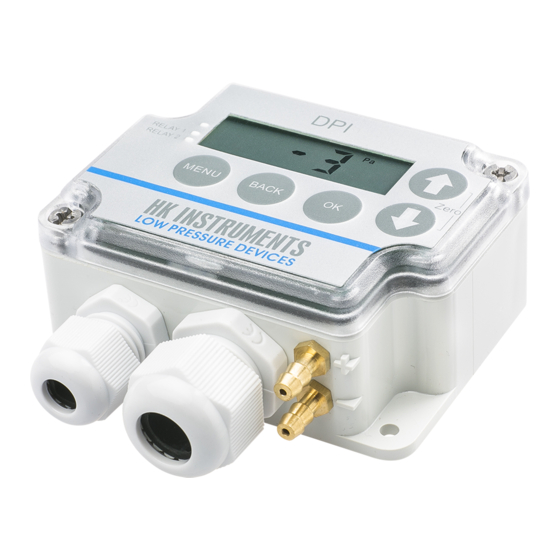
Advertisement
Quick Links
INTRODUCTION
Thank you for choosing an HK Instruments DPI series electronic
differential pressure switch. The DPI series is intended for use
in commercial environments. It combines the advantages of an
electronic differential pressure switch (on-off relay) and a multi-
functional differential pressure transmitter to meet your job re-
quirements.
The DPI series is comprised of the DPI±500 with bi-directional
measurement ranges from ±100 to ±500 Pa and the DPI2500 with
measurement ranges from 100 to 2500 Pa.
All DPI series devices include one relay, display, manual pushbut-
ton zero point calibration and span point calibration. Optional fea-
tures include a second relay and autozero calibration.
APPLICATIONS
DPI series devices are commonly used in HVAC/R systems for:
• fan, blower and filter monitoring
• staircase pressure monitoring and alarm
SPECIFICATIONS
• pressure monitoring in cleanrooms
• boiler pressure monitoring and alarm
SPECIFICATIONS
Performance
Accuracy:
±0.7 % (±1.5 % initial)
%/FS from highest pressure range including:
general accuracy, temperature drift, linearity, hysteresis,
and repetition error.
Long term stability:
Typical 1 year
With autozero: ±1 Pa
Without autozero: ±8 Pa
Overpressure:
Proof pressure: 25 kPa
Burst pressure: 30 kPa
Zero point calibration:
Automatic with autozero (-AZ) circuit or
Manual via menu
Response time:
0.5–10 s, selectable via menu
Technical Specifications
Media compatibility:
Dry air or non-aggressive gases
Measuring units:
Pa, kPa, mmWC, inWC, mbar selectable via menu
Measuring element:
Piezoresistive
Environment:
Operating Temperature:
Without autozero : -10...50 °C
With autozero: -5...50 °C
Storage temperature: -20...70 °C
Humidity: 0 to 95 % rH, non condensing
Copyright HK Instruments 2014
DIFFERENTIAL PRESSURE SWITCHES
DPI Series
• READ THESE INSTRUCTIONS CAREFULLY BEFORE
ATTEMPTING TO INSTALL, OPERATE OR SERVICE THIS
DEVICE.
• Failure to observe safety information and comply with
instructions can result in PERSONAL INJURY, DEATH AND/OR
PROPERTY DAMAGE.
• To avoid electrical shock or damage to equipment, disconnect
power before installing or servicing and use only wiring with
insulation rated for full device operating voltage.
• To avoid potential fire and/or explosion do not use in potentially
flammable or explosive atmospheres.
• Retain these instructions for future reference.
• This product, when installed, will be part of an engineered
system whose specifications and performance characteristics
are not designed or controlled by HK Instruments. Review
applications and national and local codes to assure that the
installation will be functional and safe. Use only experienced
and knowledgeable technicians to install this device.
Physical
Dimensions:
Case: 89 x 86.5 x 37.1 mm
Weight:
150 g
Mounting:
Case: 2 each 4.3 mm holes
Lid: 2 each 4.3 mm holes
Materials:
Case: ABS
Lid: PC
Duct connectors: ABS
Tubing: PVC
Protection standard:
IP54
Touch sensitive buttons on the lid:
Menu, Back, OK, down arrow, up arrow
Display:
3 1/2 digit LCD backlit display
Size: 46.0 W x 14.5 H mm
Electrical connections:
n/out:
Terminal block (24 V, GND, 0–10 V)
Wire: 12–24 AWG (0.2–1.5 mm
Relay 1:
Terminal block (NC, COM, NO)
Wire: 12–24 AWG (0.2–1.5 mm
Relay 2:
Terminal block (NC, COM, NO)
Wire: 12–24 AWG (0.2–1.5 mm
Cable entries:
Strain relief: M16 & M20
Knockout : 16 mm
Knockout : 20 mm
www.hkinstruments.fi
WARNING
Pressure fittings:
5.2 mm barbed brass
+ High pressure
− Low pressure
Electrical
Circuit: 3-wire (24 V, GND, 0–10 V)
Input:
Without autozero: 21–35 VDC/ 24 VAC, ±10 %
With autozero: 24 VAC or VDC, ±10 %
Output:
Analog: 0–10 V
Relay 1: 250 VAC / 30 VDC / 6 A
Relay 2: 250 VAC / 30 VDC / 6 A
Resistance minimum: 1 kΩ
Current consumption:
35 mA + relays (7 mA each) + AZ circuit (20 mA)
+ 0–10 V output (10 mA)
Conformance
Meets requirements for CE marking:
EMC Directive 2004/108/EC
RoHS Directive 2002/95/EC
LVD Directive: 2006/95/EC
)
2
)
2
)
2
INSTALLATION
INSTRUCTIONS
Installation version 2.0 2014
Advertisement

Summary of Contents for HK Instruments DPI Series
- Page 1 INSTRUCTIONS DPI Series INTRODUCTION WARNING Thank you for choosing an HK Instruments DPI series electronic • READ THESE INSTRUCTIONS CAREFULLY BEFORE differential pressure switch. The DPI series is intended for use ATTEMPTING TO INSTALL, OPERATE OR SERVICE THIS in commercial environments. It combines the advantages of an DEVICE.
- Page 2 3) Mount with appropriate screws. Figure 1a - Surface mounting DIMENSIONAL DRAWINGS 86.5 37.1 74.5 Figure 1b - Mounting orientation Figure 1c - Application connections Static pressure Filter/Damper Fan/Blower monitoring monitoring connected Copyright HK Instruments 2014 www.hkinstruments.fi Installation version 2.0 2014...
- Page 3 With the button you can open new options or con rm changes and return to previous display. With the buttons you can scroll the menus. Copyright HK Instruments 2014 www.hkinstruments.fi Installation version 2.0 2014...
- Page 4 During the 4 second adjustment period, the output and display values will freeze to the latest measured value. Transmitters equipped with the autozero calibration are virtually maintenance free. Copyright HK Instruments 2014 www.hkinstruments.fi Installation version 2.0 2014...



Need help?
Do you have a question about the DPI Series and is the answer not in the manual?
Questions and answers